Explore Matsumoto - Japan Travel, Asia
Nestled in the heart of Nagano Prefecture, Matsumoto is a captivating city that offers a blend of traditional Japanese charm and stunning natural beauty. Surrounded by the majestic Japanese Alps, it’s the perfect destination for travelers seeking an authentic and peaceful experience. From its iconic Matsumoto Castle to its vibrant local festivals, Matsumoto is a destination that caters to all kinds of travelers. The city offers the warmth of small-town Japan, with friendly locals and breathtaking landscapes waiting to be explored. Let's dive into everything that makes Matsumoto a must-visit destination for your next trip to Japan.
Population: Approximately 240,000 in 2019.
Economy: Matsumoto's economy focuses on a mix of tourism, agriculture, and local craftsmanship. The city is known for wasabi farming, traditional arts, and a growing role as a cultural and outdoor travel destination.
Landmarks: Famous for the Matsumoto Castle, Daio Wasabi Farm, and the Japan Ukiyo-e Museum.
Japan
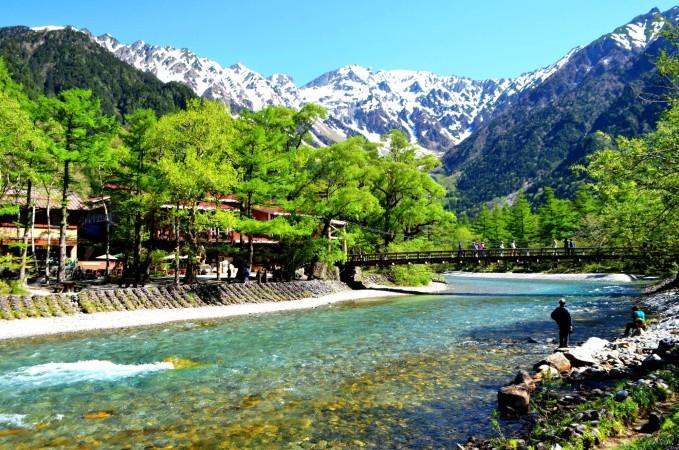
Overview of Matsumoto
History & Cultural Influence
Matsumoto is not just another city in Japan; it’s a place where history comes alive. One of its most famous landmarks, Matsumoto Castle, dates back to the 16th century and is one of Japan's few remaining original castles. It is known as the "Crow Castle" due to its distinctive black facade that represents the city's strong ties to ancient Japan's samurai era. However, the city's historical significance doesn’t stop there. Many of its streets still retain their old-world charm, with a large number of traditional houses. The city's galleries also reflect the impact of Ukiyo-e art, particularly the Japan Ukiyo-e Museum, which houses one of the world's greatest collections of these prints.
Read more about our exclusive tour to Matsumoto here.
Interaction with The Locals
Matsumoto has roughly 240,000 population, making it a mid-sized city in Nagano Prefecture. The population is a blend of locals with deep cultural roots and a growing number of newcomers drawn by the city's charm. Despite modernization, the community maintains a peaceful, small-town atmosphere, reflecting the values of Japanese rural life.
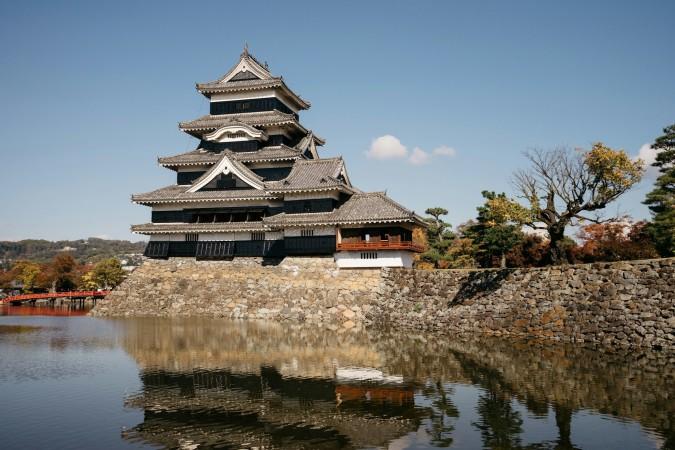
Matsumoto Castle - © Markus Winkler
Top Attractions in Matsumoto
Matsumoto is a city brimming with cultural landmarks, natural beauty, and unique experiences. Let’s take a deeper dive into some of the top attractions that you absolutely shouldn't miss during your visit.
Matsumoto Castle
Matsumoto Castle, popularly known as the "Crow Castle" for its distinctive black exterior, is one of Japan's best-preserved ancient castles and a reminder of the country's feudal era. The castle was built in the late 16th century and operated as a stronghold throughout the Warring States Period. Today, it remains one of the country’s five national treasure castles. Visitors can tour the castle’s interior, where narrow, steep staircases lead to exhibits on samurai armor and weaponry, offering a glimpse into the military strategies of the era.
Daio Wasabi Farm
Located just outside Matsumoto, the Daio Wasabi Farm is one of the largest wasabi farms in Japan. The farm is a lush, sprawling area fed by crystal-clear streams sourced from the Japanese Alps. Visitors can take a leisurely walk around the farm’s beautifully maintained paths, passing by charming wooden bridges and waterwheels that make the place feel like a scene from traditional Japan. You can also learn about the delicate cultivation process of wasabi, which requires clean, cool water to grow properly.
Kamikochi
For nature enthusiasts, Kamikochi is an unmissable destination. Situated in the Hida Mountains (part of the Japanese Alps), this stunning alpine valley is one of Japan’s most breathtaking natural wonders. The area is known for its crystal-clear waters, peaceful meadows, and dramatic mountain landscapes. Kamikochi, along with Nagano Prefecture, is especially popular among hikers and nature photographers who are drawn to its serene beauty and wildlife, including monkeys and rare birds.
Japan Ukiyo-e Museum
Art enthusiasts in Matsumoto should surely visit the Japan Ukiyo-e Museum, which houses the world's biggest private collection of Ukiyo-e woodblock prints. The prints displayed here offer a unique window into Japan’s artistic and cultural history, with vivid depictions of landscapes, kabuki actors, sumo wrestlers, and scenes from everyday life. Visitors can also learn about the delicate art of woodblock printing and its role in spreading popular culture in Edo-era Japan.
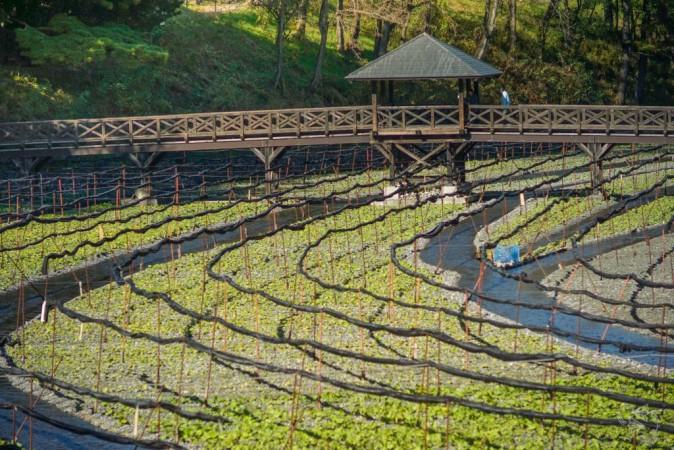
Daio Wasabi Farm - © Notes of Nomads
Must-Try Dishes in Matsumoto
- Shinshu Soba: Famed throughout Nagano Prefecture, Shinshu Soba is a staple dish made from buckwheat grown in the area’s highlands. The noodles have a slightly nutty flavor and are served either chilled with a dipping sauce (zaru soba) or hot in a savory broth (kake soba) with tempura on the side.
- Oyaki: Oyaki are steamed or grilled dumplings filled with a variety of savory or sweet ingredients. Popular varieties include pumpkin, nozawana (pickled mustard greens), and adzuki bean paste. These hearty dumplings are perfect for a quick snack and are a beloved comfort food among locals.
- Toji Soba: Unique to the region, Toji Soba is a variation of soba noodles where diners dip them into hot broth, similar to how shabu-shabu is eaten. It’s particularly popular in the colder months and offers a warm, comforting meal experience.
- Gohei Mochi: Gohei Mochi, a traditional snack from Nagano, is the most flavorful way to experience the countryside. This grilled rice cake is skewered, covered in a sweet miso or soy sauce glaze, and grilled over an open flame, giving it a slightly smoky flavor.
- Sanzoku-yaki: A Matsumoto specialty, Sanzoku-yaki is a hearty dish of large, marinated fried chicken cutlets. Sanzoku-yaki is robust, seasoned with garlic and soy sauce, and typically served as a main dish alongside rice. The name translates to “bandit chicken,” and its bold flavors make it a favorite among locals and visitors alike.
- Togakushi Soba: While not exclusive to Matsumoto, Togakushi Soba is a renowned dish from the nearby Togakushi region. It features thin, firm soba noodles served cold with a rich dipping sauce made from soy sauce, mirin, and dashi.
If you are interested in knowing more about other region cuisines, check out our article about Nagano here.
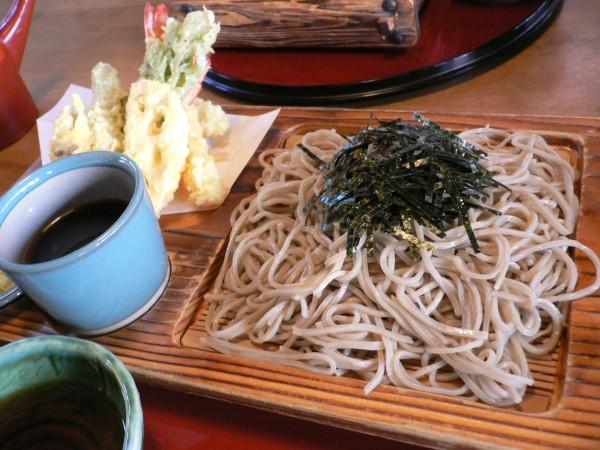
Shinshu Soba - © Wikipedia
Festivals & Local Celebrations
Matsumoto’s cultural vibrancy truly comes alive through its festivals, where locals and visitors come together to celebrate the city’s traditions, music, and seasonal events. These festivals are a great way to immerse yourself in the local culture and experience the unique spirit of Matsumoto.
Matsumoto Taiko Drum Festival
One of the most energetic events in the city is the Matsumoto Taiko Drum Festival, held every summer. During this festival, the streets of Matsumoto come alive with the powerful sound of taiko drums. Performers from across Japan gather to showcase their drumming skills, creating a mesmerizing atmosphere with their synchronized beats. It’s a captivating display of traditional Japanese music that resonates through the city, drawing in large crowds.
Matsumoto Bon Bon
Another key event is the Matsumoto Bon Bon, a summer dance festival that sees the streets filled with locals and tourists alike, all dancing to the beat of the Bon Bon dance. The festival is a celebration of unity, where participants wear colorful yukata (summer kimonos) and perform the traditional dance in groups. The festival encourages everyone to join in, making it a fun and interactive way to experience Japanese culture.
Setsubun at Fukashi Shrine
During Setsubun in February, Matsumoto’s Fukashi Shrine hosts a lively event where locals throw roasted soybeans to ward off evil spirits and invite good fortune. This is a traditional celebration that marks the start of spring and provides an interesting glimpse into Japan’s spiritual customs.
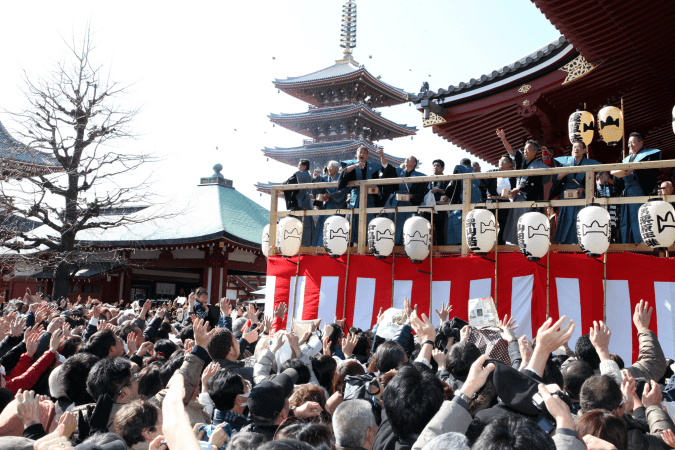
Setsubun at Fukashi Shrine - © TimeOut
What to Do in Matsumoto
- Hiking Trails in Matsumoto: Surrounded by the Japanese Alps, Matsumoto is a gateway to some of Japan’s most stunning natural landscapes. Kamikochi is a top destination for nature lovers, offering scenic hiking trails through valleys, forests, and along rivers. For a less strenuous activity, a stroll around Utsukushigahara Highlands is perfect for enjoying panoramic views of the surrounding peaks.
- Cycling Tours Around Matsumoto: Matsumoto is a bike-friendly city, and renting a bicycle is one of the best ways to explore its charming streets. You can ride along the peaceful riverside paths or cycle through historical districts like Nakamachi Street.
- Experience Cultural Workshops: Try your hand at soba noodle making, or join a wasabi-picking experience at Daio Wasabi Farm. If you’re interested in the arts, woodblock printing classes inspired by Ukiyo-e are also available, giving you the chance to create your own piece of Japanese art to take home.
Shopping in Matsumoto
- Nakamachi Street: One of the most popular areas for shopping is Nakamachi Street, known for its traditional white-walled kura (storehouses). These beautiful historical buildings have been converted into stylish shops selling handmade crafts, pottery, and local textiles.
- Nawate-dori: For something a bit more quirky, Nawate-dori, also called "Frog Street," is a fun place to explore. Lined with small stalls and shops, it offers a mix of antiques, sweets, and frog-themed merchandise. It's a lively street that captures the playful side of Matsumoto’s local culture, making it a fun stop for families and casual shoppers.
- Local Markets: Matsumoto also has several local markets where you can purchase fresh produce and handmade goods just like other places around Japan. The Farmers Market near Matsumoto Castle is perfect for sampling local products like fresh vegetables, Nagano apples, and traditional snacks.
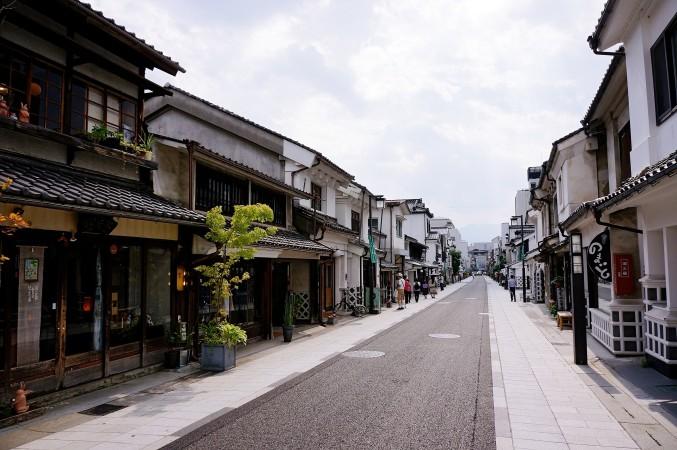
Nakamachi Street - © Wikimedia
Weather in Matsumoto: Best Time to Visit
Understanding the weather in Matsumoto is essential for planning the best time to visit, especially since this scenic city experiences all four distinct seasons, each offering its own unique charm.
Spring in Matsumoto
Spring is one of the most beautiful times to visit Matsumoto as the temperature is mostly between 5°C to 20°C (41°F to 68°F). The city comes alive with cherry blossoms, especially around Matsumoto Castle and along the Metoba River. Mild temperatures make it perfect for outdoor activities like hiking in Kamikochi or cycling through the town’s charming streets.
Summer in Matsumoto
Summer brings warm temperatures, around 18°C to 30°C (64°F to 86°F), ideal for exploring Matsumoto’s natural beauty. It’s the best time for hiking in the Japanese Alps and enjoying the lush greenery of Kamikochi. The Matsumoto Taiko Drum Festival and the Matsumoto Bon Bon are also held during the summer months, offering visitors a chance to experience lively local culture.
Read more about the best time to visit Japan here.
Autumn in Matsumoto
Autumn is arguably the most picturesque season in Matsumoto with temperatures ranging from 10°C to 25°C (50°F to 77°F). The mountains surrounding the city burst into shades of red, orange, and yellow, creating stunning views for visitors. The crisp, cool air is perfect for sightseeing or walking around the old samurai streets. Autumn is also harvest season, making it a fantastic time to enjoy local produce and dishes like Oyaki and Shinshu Soba.
Winter in Matsumoto
Winters in Matsumoto are cold and often snowy, particularly in the surrounding mountains as the temperatures range from -5°C to 5°C (23°F to 41°F). This is the time to visit nearby ski resorts or enjoy the tranquility of a snow-covered Matsumoto Castle. Winter offers a peaceful atmosphere with fewer tourists, making it ideal for those who enjoy a quieter travel experience.
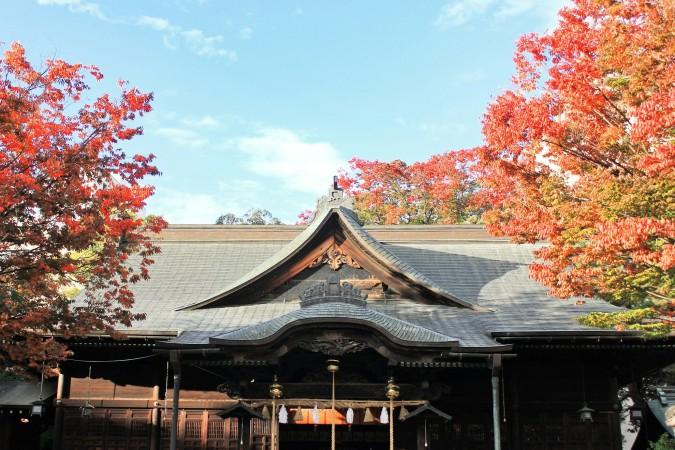
Autumn in Matsumoto - © Weiqi Xiong
Essential Travel Information
Getting Around Matsumoto
- JR Matsumoto Station: Matsumoto is well-connected with JR Matsumoto Station serving as the main transportation hub. Trains from Matsumoto connect to Tokyo and other parts of Nagano Prefecture, including the nearby Kamikochi area.
- Local Buses: The local bus system in Matsumoto is convenient for getting to outlying attractions such as Daio Wasabi Farm or the Kamikochi hiking area. Tourist passes are available, which offer unlimited rides on certain bus routes for a fixed price.
- Cycling: Matsumoto is a bike-friendly city, and cycling is a great way to explore. Bike rentals are available near Matsumoto Castle and at various shops around the city. Popular cycling routes include the riverside paths and the charming historical streets of Nakamachi.
- Taxis and Walking: Taxis are widely available in Matsumoto for those who prefer a quicker, more private option. Walking is another excellent way to explore the city, especially around Nawate-dori and Nakamachi Street, where you can immerse yourself in the local atmosphere at a leisurely pace.
ATM & Banking Services
Matsumoto offers plenty of ATM and banking services for visitors, making it easy to access cash during your stay. While many businesses in Matsumoto accept card payments, it's still advisable to carry some cash, as smaller shops and restaurants may prefer cash transactions. Currency exchange services are also available at central locations, ensuring a smooth financial experience during your trip.
Where to Stay in Matsumoto
- Ryokan (Traditional Japanese Inns): Staying at a ryokan provides an authentic Japanese experience, where you can sleep on tatami mats, enjoy a traditional kaiseki (multi-course) meal, and often relax in natural onsen (hot spring) baths.
- Hotels: Matsumoto has a range of mid-range and luxury hotels located near the city center and the train station, offering modern amenities and comfortable rooms. These hotels cater to both business and leisure travelers, providing convenience and accessibility for visitors looking for a hassle-free stay.
- Farm Stays: For a unique rural experience, consider staying at a farm stay in the surrounding countryside. These accommodations offer the chance to experience traditional Japanese farming life, often including homemade meals made from fresh local ingredients.
Articles for you

Explore Yala National Park - Sri Lanka Travel, Asia
Tucked away in Sri Lanka’s southeastern corner, Yala National Park is where wild nature meets deep tradition. Known worldwide for its leopard population, the park is also home to elephants, sloth bears, crocodiles, and hundreds of bird species. Beyond wildlife, Yala opens doors to a cultural landscape dotted with ancient temples, Buddhist ruins, and coastal villages. For travelers seeking more than just a safari, Yala offers a chance to explore eco-tourism, local communities, and sacred heritage sites.
Population: The Yala National Park area doesn’t have a human population.
Economy: The economy around Yala National Park thrives on a blend of eco-tourism, agriculture, and local services. Safari tours, eco-lodges, and cultural experiences drive steady income for nearby towns like Tissamaharama and Kataragama, supporting thousands of families.
Landmarks: Famous for Block I of Yala and wildlife encounters, including elephants, sloth bears, crocodiles, and exotic bird species.

Explore Galle - Sri Lanka Travel, Asia
Nestled on Sri Lanka’s southern coastline, Galle is a vibrant city where history meets the sea. Its cobbled streets, colonial architecture, and serene beaches make it a must-visit destination for travelers seeking a blend of culture, adventure, and relaxation. A UNESCO World Heritage site, Galle captivates visitors with its Dutch Fort, bustling markets, and friendly locals. Whether you’re exploring the ramparts at sunset or savoring fresh seafood by the shore, Galle promises an unforgettable journey into Sri Lanka’s heritage.
Population: Approximately 113,000 in 2023.
Economy: Galle’s economy thrives on tourism, trade, and fisheries. The city’s historic fort, colonial architecture, and coastal charm draw thousands of international visitors each year, making tourism its main economic driver. Fishing remains vital for local livelihoods, supplying fresh seafood across the region.
Landmarks: Famous for the Galle Fort, Dutch Reformed Church & Maritime Museum, and Unawatuna Beach.

Explore Bentota - Sri Lanka Travel, Asia
Nestled along Sri Lanka’s southwestern coast, Bentota is a tropical paradise that blends golden beaches, vibrant culture, and thrilling adventures. Famous for its calm waters, luxury resorts, and scenic river estuary, Bentota has become a top destination for travelers seeking both relaxation and authentic experiences. From serene beach walks at sunrise to adrenaline-pumping water sports, this coastal town offers a perfect balance of leisure and exploration. With its proximity to Colombo and Galle, Bentota is easy to reach, making it an ideal stop for both short escapes and extended holidays.
Population: Approximately 37,000 in 2023.
Economy: Bentota’s economy thrives mainly on tourism, which drives local businesses such as hotels, restaurants, and wellness retreats. The town also benefits from fishing, coconut cultivation, and handicrafts like wood carving and batik textiles. Many residents rely on the growing demand for water sports and Ayurvedic treatments, making tourism the backbone of both income and employment in the area.
Landmarks: Famous for Bentota Beach, Bentota River Safari, and Kande Vihara Temple.

Explore Mirissa - Sri Lanka Travel, Asia
Mirissa is a charming coastal town on Sri Lanka’s southern shoreline. Known for its golden beaches, turquoise waters, and vibrant marine life, it has become a must-visit stop for travelers exploring the island. Many come for whale watching, surfing, and sunset views at Coconut Tree Hill, but Mirissa offers much more than postcard beauty. The fishing boats you see anchored by the bay carry generations of stories. Local traditions, delicious cuisine, and a laid-back rhythm of life shape every visitor’s experience.
Population: Approximately 4,700 in 2023.
Economy: Mirissa’s economy is largely shaped by its coastal location. Fishing has long been the backbone of local livelihoods, with generations relying on the Indian Ocean for income. In recent decades, tourism has become the main driver of growth, thanks to whale watching, surfing, and beachside hospitality.
Landmarks: Famous for Mirissa Beach, Coconut Tree Hill, and Parrot Rock Bridge.

Explore Nuwara Eliya - Sri Lanka Travel, Asia
Tucked away in the Central Highlands of Sri Lanka, Nuwara Eliya is often called “Little England”. With its rolling tea plantations, cool misty mornings, and colonial charm, this mountain town feels like a step into another world. Travelers come here to breathe fresh air, walk through flower gardens, sip the finest Ceylon Tea, and enjoy a pace of life far from the island’s busy cities. Whether you’re drawn by scenic landscapes, heritage architecture, or the warmth of its people, Nuwara Eliya is a destination that blends nature, culture, and history in perfect harmony.
Population: Approximately 781,000 in 2023.
Economy: Nuwara Eliya’s economy thrives mainly on tea production, as it sits in the heart of Sri Lanka’s central highlands, famous worldwide for Ceylon Tea. The city also benefits from a growing tourism industry, attracting visitors with its colonial charm, cool climate, and scenic landscapes.
Landmarks: Famous for Gregory Lake, Hakgala Botanical Garden, and Victoria Park.

Explore Sukau - Malaysia Travel, Asia
Nestled on the banks of the Kinabatangan River in Sabah, Malaysian Borneo, Sukau is a destination where wildlife, culture, and conservation come together. Known as one of Asia’s top spots for river safaris and eco-tourism, this quiet village offers a front-row seat to encounters with Bornean orangutans, pygmy elephants, proboscis monkeys, and exotic birdlife.
Population: Approximately 1,400 in 2019.
Economy: Sukau’s economy is shaped by its riverine location and natural resources. Traditionally, the Orang Sungai community relied on fishing, small-scale farming, and forest gathering for their livelihood. Today, the village has shifted toward eco-tourism, with river cruises, jungle trekking, and homestays providing income.
Landmarks: Famous for the Kinabatangan River cruises, Gomantong Caves, and Ox-bow lakes and wetlands.
